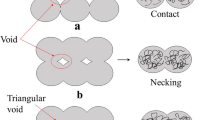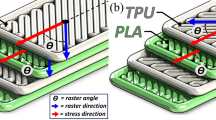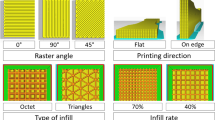Abstract
Multi-material forming in three dimensional (3D) printing is drawing attention because of its larger functionality. In this paper, dissimilar materials sample involving polylactic acid (PLA) and thermoplastic polyurethane (TPU) were prepared in laminating via fusion deposition modeling (FDM) 3D printing technology, and they varied volume fraction of TPU and material layouts. Compared with the 3D printed samples of single PLA and single TPU, the tensile behaviors of the PLA/TPU sample with dissimilar materials were examined. The results found that the tensile strength and elastic modulus of 3D printed PLA/TPU were sensitive to TPU volume. A model for predicting and evaluating the tensile strength of 3D printed PLA/TPU was proposed, which was verified by the experimental data. Furthermore, at a given volume ratio of TPU, PLA/TPU samples with different material layouts showed distinct tensile performances. Besides, the specimen surface morphology and the fracture topography of PLA/TPU samples were observed by scanning electron microscopy. The underlying failure mechanisms of these dissimilar material printed specimens were investigated. The findings enable designers to design more reliable multi-material structures for 3D printed parts.










Similar content being viewed by others
References
Li B, Zhang SZ, Zhang L, Gao Y, Xuan FZ (2022) Strain sensing behavior of FDM 3D printed carbon black filled TPU with periodic conFig.urations and flexible substrates. J Manuf Process 73:283–295. https://doi.org/10.1016/j.jmapro.2021.12.020
Melenka GW, Cheung BKO, Schofield JS, Dawson MR, Carey JP (2016) Evaluation and prediction of the tensile properties of continuous fiber-reinforced 3D printed structures. Compos Struct 153:866–875. https://doi.org/10.1016/j.compstruct.2016.07.018
Cheng P, Wang K, Chen XZ, Wang J, Peng Y, Ahzi S, Chen C (2021) Interfacial and mechanical properties of continuous ramie fiber reinforced biocomposites fabricated by in-situ impregnated 3D printing. Ind Crops Prod 170:113760. https://doi.org/10.1016/j.indcrop.2021.113760
Samar JK, Bose S, Hosick H, Bandyopadhayay A (2003) Development of controlled porosity polymer-ceramic composite scaffolds via fused deposition modeling. Mater Sci Eng C 23(5):611–620. https://doi.org/10.1016/S0928-4931(03)00052-3
Thrimurthulu K, Pandey PM, Reddy NV (2004) Optimum part deposition orientation in fused deposition moldeling. Int J Mach Too Manu 44(6):585–594. https://doi.org/10.1016/j.ijmachtools.2003.12.004
Athanasiou KA, Niederauer GG, Agrawal CM (1996) Sterilization, toxicity, biocompatibility and clinical applications of polylactic acid/ polyglycolic acid copolymers. Biomaterials 17(2):93–102. https://doi.org/10.1016/0142-9612(96)85754-1
Zhang P, Hu ZC, **e HX, Lee GH, Lee CH (2019) Friction and wear characteristics of polylactic acid (PLA) for 3D printing under reciprocating sliding condition. Ind Lubr Tribol 72(4):533–539. https://doi.org/10.1108/ILT-11-2016-0280
Radano CP, Baker GL, Smith MR (1996) Stereoselective polymerization of a racemic monomer with a racemic catalyst: direct preparation of the polylactic acid stereocomplex from racemic lactide. J Am Chem Soc 33(122):585–597. https://doi.org/10.1021/ja9930519
Wang YS, Lyu CH, Zhang Q, Li W, Liu J (2021) Preparation and performance index test of continuous glass fiber reinforced filament- polylactic acid for 3D printer. J Phys: Conf Ser 1906(1):012053. https://doi.org/10.1088/1742-6596/1906/1/012053
Miclaus R, Repanovic A, Roman N (2017) Biomaterials: Polylactic acid and 3d printing processes for orthosis and prosthesis. Mater Plast 54(1):98–102. https://doi.org/10.37358/MP.17.1.4794
Orozco-Díaz CA, Moorehead R, Reilly GC, Gilchris F, Miller C (2020) Characterization of a composite polylactic acid-hydroxyapatite 3D-printing filament for bone-regeneration. Biomed Phys Eng Express 6(2):025007. https://doi.org/10.1088/2057-1976/ab73f8
Nampitch T (2021) Mechanical, thermal and morphological properties of polylactic acid/ natural rubber/ bagasse fiber composites foams. Res Mater 12:100225. https://doi.org/10.1016/j.rinma.2021.100225
Jašo V, Cvetinov M, Rakić S, Petrović ZS (2015) Bio-plastics and elastomers from polylactic acid/thermoplastic polyurethane blends. J Appl Polym Sci 131(22):547–557. https://doi.org/10.1002/app.41104
Shi XJ, Chen BC, Tuo XH, Gong YM, Guo J (2020) Study on performance characteristics of fused deposition modeling 3D printed composites by blending and lamination. J Appl Polym Sci 138(9):32495. https://doi.org/10.1002/app.49926
Dezaki LM, Ariffin MKAM, Serjouei A, Zolfagharian A, Hatami S, Bodaghi M (2021) Influence of infill patterns generated by cad and fdm 3d printer on surface roughness and tensile strength properties. Appl Sci 11(16):7272. https://doi.org/10.3390/app11167272
Kultravut K, Kuboyama K, Ougizawa T (2020) Annealing effect on tensile property and hydrolytic degradation of biodegradable poly (lactic acid) reactive blend with poly(trimethylene terephthalate) by two-step blending procedure. Polym Degrad Stab 179:109228. https://doi.org/10.1016/j.polymdegradstab.2020.109228
Lopes LR, Silva AF, Carneiro OS (2018) Multi-Material 3D Printing: The relevance of materials affinity on the boundary interface performance. Addit Manuf 23:45–52. https://doi.org/10.1016/j.addma.2018.06.027
Singh R, Kumar R, Farina I, De Piano M, Amendola A, Fraternali F (2018) Mechanical and experimental study on the use of sustainable materials for additive manufacturing. Abstracts of the 5th Advanced Materials, Mechanics and Structural Engineering Conference (AMMSE 2018):16–17
Zhang B, Wang L, Song P, Pei X, Zhang X (2021) 3d printed bone tissue regenerative pla/ha scaffolds with comprehensive performance optimizations. Mater Des 201(1):109490. https://doi.org/10.1016/j.matdes.2021.109490
Steinmetz EB, Sawicki J, Byczkowska P (2021) The influence of 3d printing parameters on adhesion between polylactic acid (pla) and thermoplastic polyurethane (tpu). Materials 14(21):6264. https://doi.org/10.3390/ma14216464
Liao Y, Liu C, Coppola B, Barra G, Lafdi K (2019) Effect of porosity and crystallinity on 3d printed pla properties. Polymers 11(9):1487. https://doi.org/10.3390/polym11091487
Hassanajili S, Karami-Pour A, Oryan A, Talaei-Khozani T (2019) Preparation and characterization of PLA/PCL/HA composite scaffolds using indirect 3D printing for bone tissue engineering. Mater Sci Eng C 104:109960. https://doi.org/10.1016/j.msec.2019.109960
Carrasco F, Pagès P, Gámez-Pérez J, Santana OO, Maspoch ML (2010) Processing of poly(lactic acid): characterization of chemical structure, thermal stability and mechanical properties. Polym Degrad Stabil 95(2):116–125. https://doi.org/10.1016/j.polymdegradstab.2009.11.045
Hutchinson JW, Suo Z (1992) Mixed mode cracking in layered materials. Adv Appl Mech 29:63–191. https://doi.org/10.1016/S0065-2156(08)70164-9
Tamburrino F, Graziosi S, Bordegoni M (2019) The influence of slicing parameters on the multi-material adhesion mechanisms of FDM printed parts: An exploratory study. Virtual Phys Prototyp 14:316–332. https://doi.org/10.1080/17452759.2019.1607758
Acknowledgements
This work is supported by the Natural Science Foundation of Ningbo City (Project Nos.: 2021J146) and the Science and Technology Innovation Activity Plan for college students in Zhejiang Province (Zhejiang ** Ji, Chunmei Chen, Guowei Zhang & Zujun Chen
Corresponding author
Ethics declarations
Competing interests
The authors declare that they have no known competing financial interests or personal relationships that could have appeared to influence the work reported in this paper. The authors declare the following financial interests/personal relationships which may be considered as potential competing interests.
Additional information
Publisher's Note
Springer Nature remains neutral with regard to jurisdictional claims in published maps and institutional affiliations.
Rights and permissions
About this article
Cite this article
Wang, F., Ji, Y., Chen, C. et al. Tensile properties of 3D printed structures of polylactide with thermoplastic polyurethane. J Polym Res 29, 320 (2022). https://doi.org/10.1007/s10965-022-03172-6
Received:
Accepted:
Published:
DOI: https://doi.org/10.1007/s10965-022-03172-6




